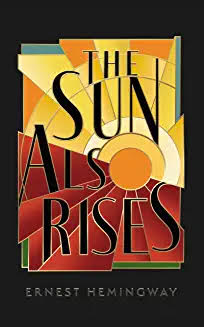"The Sun Also Rises" by Ernest Hemingway

Above: "The Sun Also Rises," by Ernest Hemingway. 189 pages.
"The Sun Also Rises" is a compelling, beautiful book, leaving one to wonder about life's meaning in a world of, tension, complexity and beauty.
I completed reading the above book today.
Circa 2010 I joined good friend El Contador (now deceased) on a trip to the Festival St. Fremin (Running of the Bulls), in Pamplona, Spain. We took an overnight ferry from Plymouth, England to Santander, Spain, rented a car, and drove to Pamplona. El Contador, who had worked seven years in Spain as an accountant, had run with the bulls several times. He had convinced me, on paper, that I could do it with him on this trip.
I copped out of the bull run when I surveyed the scene. There was no way one could run down that walled path to the corrida without a bull passing by. If you decided to run with the bulls, you would run with the bulls! A bull WOULD pass you, hopefully distracted from goring you! I was over 65 years old, in walking, not running, shape. Discretion being the better part of valor, I opted out. So, did El Contador, five years my senior, though my wily friend left open the idea that he wasn't running out of sympathy for my cowardice.
Still, we had a great time at the festival. We wore the white clothing and the red sash. We consumed a lot of sangria, we watched the running bulls, and we went to the corrida for the bull fight. The fun-loving bull fight fans nearby, seeing the two geezer foreigners seated in the corrida in their midst, mischievously tossed sangria on us. At the time, when the bull fight started, I didn't understand much about the ritual. But the event was exciting. We left the ring, all smiles, with pink, sangria saturated, shirts.
Leaving the corrida, El Contador pointed out to me the statue of Ernest Hemingway at the entrance. Looking back, after reading "The Sun Also Rises," I wish I had read the novel before I had participated in the San Fremin festival. Hemingway's account of the St. Fremin festival bull fights filled in the blanks about the bull fight ritual I had attended with El Contador.
Before reading "The Sun Also Rises," I had only read one other Hemingway novel, "The Old Man and the Sea." That novel is set in Havana, Cuba, where I had visited Hemingway's well-preserved home in 2013. The Cubans revered Hemingway, who only stopped praising Castro's revolution when US authorities threatened to take away his US passport. I have also visited other Hemingway haunts including Cafe Deux Magots in Paris, his six-claw cat estate in Key West, Florida and his home Ketchum, Idaho, where he took his life in 1961.
The narrator of "The Sun Also Rises," American Jake Barnes (really Hemingway recounting variations of his personal experiences in Europe) is an injured World War I veteran and now a newspaper reporter living in Paris. He and his friends, one woman, Brett, his erstwhile squeeze, and three other men travel to Spain to fish and to attend the Festival of St. Fremin in Pamplona. Mike, a Scot, is now betrothed to Brett. Robert, a Jew and a graduate of Princeton and a longtime friend of Jake, has been seeing Brett on the QT. Mike is ticked that Robert now doesn't seem to know he is not wanted on the trip. Mike's insults to Robert are direct and unvarnished... uncomfortable to read. There are borderline Anti-Semitic comments in the book which would be difficult to write today. Bob is another friend, the only one of the four males who hasn't had some kind of relationship with Brett.
There is a lot of cafe hopping, wine, and spirits consumed by the friends at the festival. The book can be seen as a tutorial for learning about various types of alcoholic drinks. Absinth with sugar... without sugar... yada yada. After a couple of days at the seven-day festival the party atmosphere escalates along with the tension between the characters.
Hemingway says so much in so few words. He describes the day-to-day interactions of the friends. There is seemingly no plot. Reading the novel, I thought of the Seinfeld TV series which was noted for its being "about nothing." But there is subtle meaning in the novel as there also is in the Seinfeld TV series. "The Sun Also Rises" is a description of the Lost Generation, or writers and artists who came of age in the years just after World War I. The book recounts the European travel and cafe life. Think of the novel as a handbook for American back-packers in Europe. Underneath the beautifully spare writing style, Hemingway's characters are complex. The description of the scenery is captivating and vivid. "The Sun Also Rises" is a compelling, beautiful book, leaving one to wonder about life's meaning in a world of, tension, complexity and beauty.